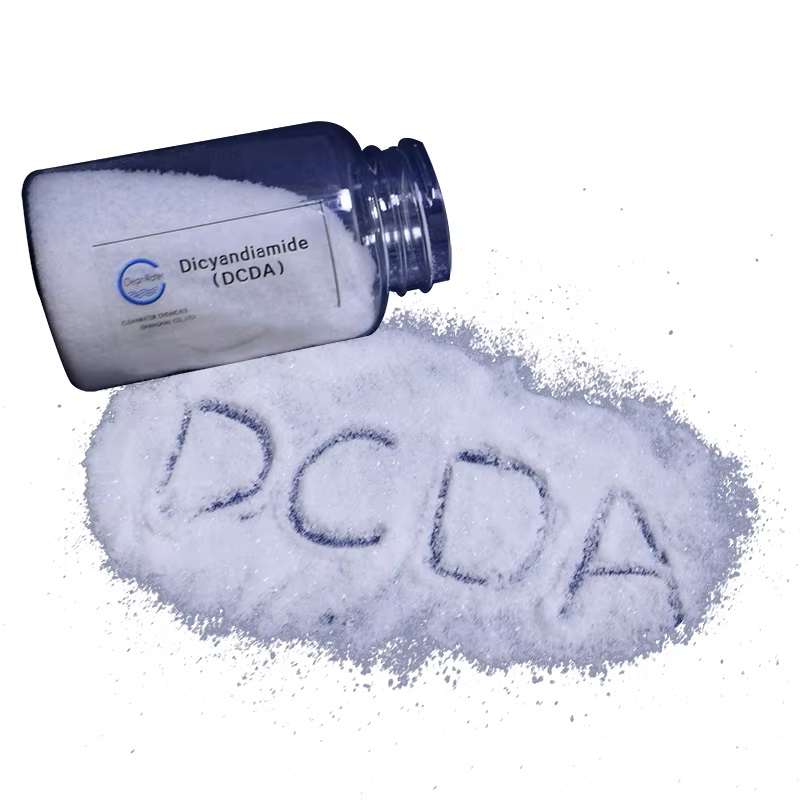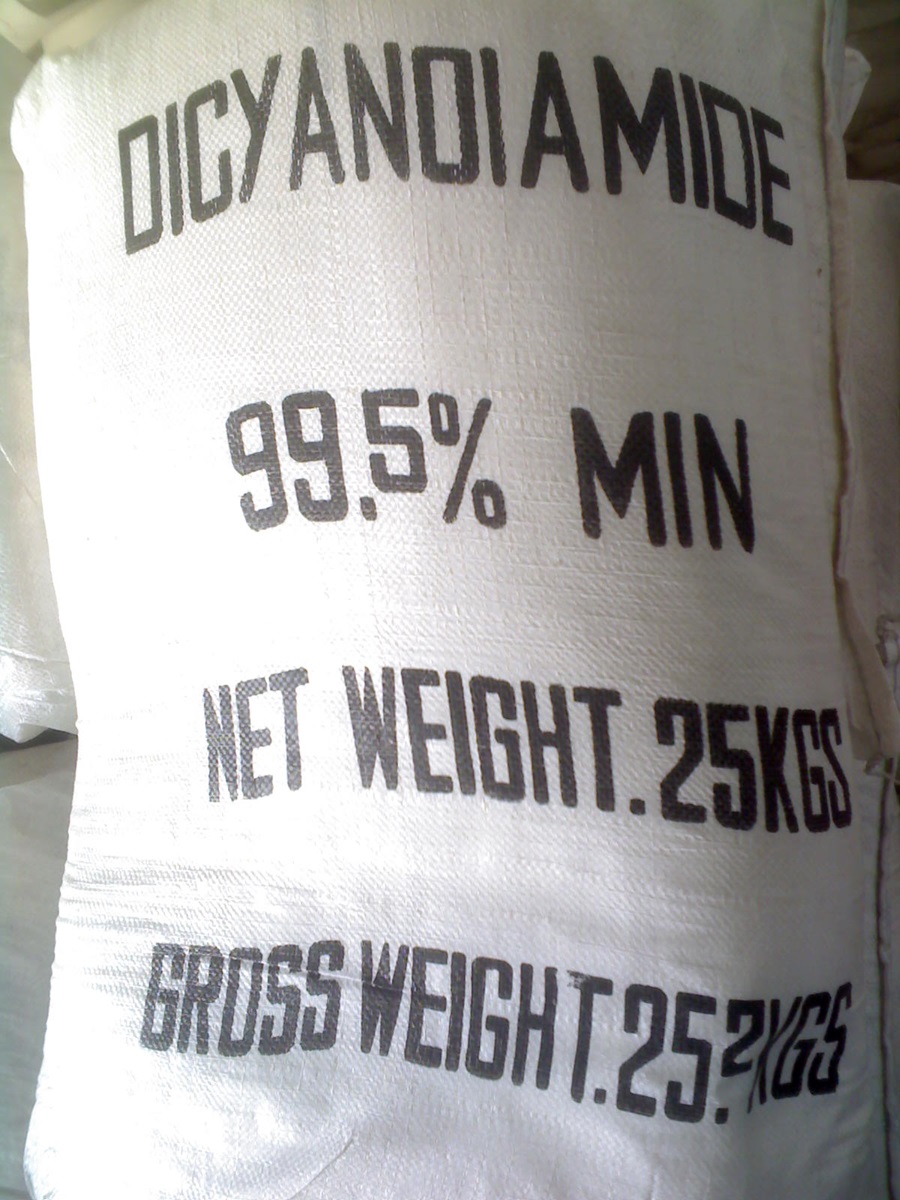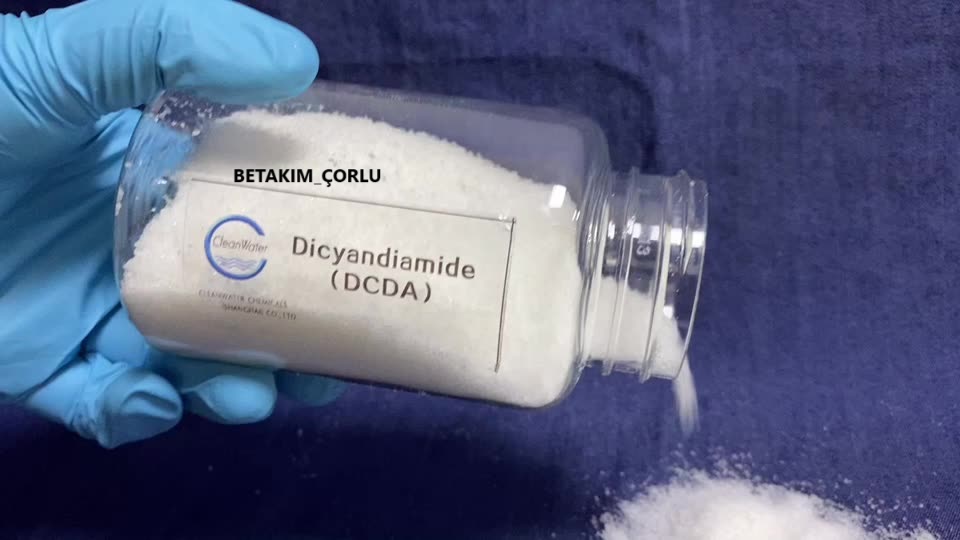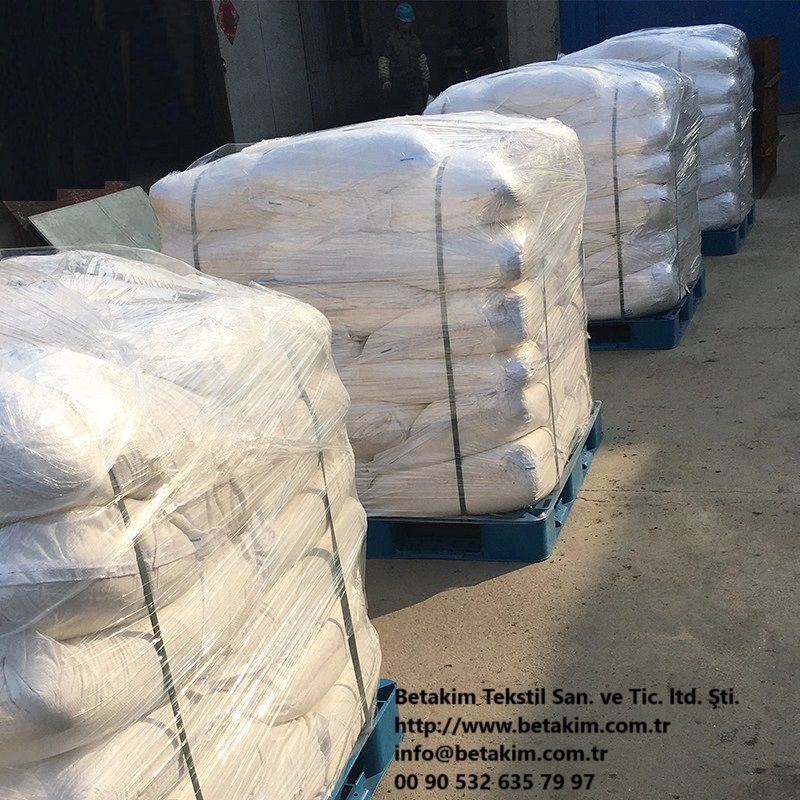We unleash your business potential by maximize the business innovation.
Send EmailDicyandiamide, Cyanoguanidine, Dicyandiamin, DCD, DCDA, 461-58-5
Dicyandiamide (DCD), also known as Disiyandiamid in Turkish, is an organic compound with the chemical formula C2H4N4. Here are some key details:
Properties:
-
Chemical Formula: C2H4N4
-
CAS Number: 461-58-5
-
Molecular Weight: 84.08 g/mol
-
Appearance: White crystalline powder
-
Odor: Odorless
-
Solubility: Soluble in water, acetone, and alcohol; insoluble in non-polar organic solvents
-
Melting Point: 209.5°C
-
Density: 1.4 g/cm³
Uses:
-
Agriculture: Used as a slow-release nitrogen fertilizer and nitrification inhibitor.
-
Adhesives: Used as a hardener in epoxy resins.
-
Chemical Industry: Used in the production of melamine and other guanidine derivatives.
-
Explosives: Previously used as a fuel in some explosives.
-
Electronics: Used in the production of epoxy laminates for circuit boards.
Other Names:
-
2-Cyanoguanidine
-
Dicyandiamide
-
N-Cyanoguanidine
-
1-Cyanoguanidine
-
Guanidine-1-carbonitrile
-
Dicyandiamin
-
DCD
CAS: 461-58-5
Molecular Formula: C2H4N4
Names and Identifiers
| Name | Dicyandiamide |
| Synonyms | DCD DCDA xb2879b Pyroset DO epicuredicy7 epicuredicy15 Dicyandiamide Dicyanodiamide Cyanoguanidine 2-Cyanoguanidine N-Cyanoguanidine 1-Cyanoguanidine Guanidine, cyano- Guanidine-1-carbonitrile diamino(cyanoiminio)methane |
| CAS | 461-58-5 |
| EINECS | 207-312-8 |
| InChI | InChI=1/C2H4N4/c3-1-6-2(4)5/h(H4,4,5,6)/p+1 |
| InChIKey | QGBSISYHAICWAH-UHFFFAOYSA-N |
Physico-chemical Properties
| Molecular Formula | C2H4N4 |
| Molar Mass | 84.08 |
| Density | 1.40 |
| Melting Point | 208-211 °C (lit.) |
| Boling Point | 144.35°C (rough estimate) |
| Flash Point | 92.8°C |
| Water Solubility | 32 g/L (20 ºC) |
| Solubility | Soluble in Water: 0.1 g/mL |
| Vapor Presure | 0.001Pa at 20℃ |
| Appearance | White powder |
| Color | White |
| Merck | 14,3092 |
| BRN | 605637 |
| pKa | 0.73±0.70(Predicted) |
| Storage Condition | 2-8°C |
| Stability | Stable. Incompatible with strong acids, strong oxidizing agents, strong bases. |
| Sensitive | Easily absorbing moisture |
| Refractive Index | 1.6260 (estimate) |
| MDL | MFCD00008066 |
| Physical and Chemical Properties | Properties White prismatic crystalline powder "[purpose] used as fertilizer, nitrocellulose stabilizer, rubber vulcanization accelerator, also used in the preparation of guanidine salt, melamine, barbituric acid and so on. " |
| Use | Used as fertilizer, nitrocellulose stabilizer, rubber vulcanization accelerator, also used in the preparation of guanidine salt, melamine, barbituric acid, etc., is also the raw material of melamine and the intermediate of synthetic medicine, pesticide and dye |
Risk and Safety
| Risk Codes | R20/21/22 - Harmful by inhalation, in contact with skin and if swallowed. R43 - May cause sensitization by skin contact R36/38 - Irritating to eyes and skin. R25 - Toxic if swallowed |
| Safety Description | S22 - Do not breathe dust. S24/25 - Avoid contact with skin and eyes. S45 - In case of accident or if you feel unwell, seek medical advice immediately (show the label whenever possible.) S36 - Wear suitable protective clothing. S3 - Keep in a cool place. |
| UN IDs | UN 2811 6.1 / PGIII |
| WGK Germany | 1 |
| RTECS | ME9950000 |
| TSCA | Yes |
| HS Code | 29262000 |
| Toxicity | LD50 orally in Rabbit: > 5000 mg/kg LD50 dermal Rabbit > 2000 mg/kg |
Upstream Downstream Industry
| Raw Materials | Charcoal calcium cyanamide |
| Downstream Products | Guanidine nitrate Amidinothiourea Metsulfuron methyl moroxydine Metformin HCL Guanidinium sulphamate |
Nature
White rhomboid crystalline powder, non-flammable. The relative density was 1. 400. The melting point was 207-209 °c. Slightly soluble in water and ethanol, insoluble in ether and benzene. The dried dicyandiamide is stable in nature.
Preparation Method
lime nitrogen is used as raw material to hydrolyze with water, and the hydrolyzed liquid in suspension obtained from the reaction is filtered under reduced pressure to remove Ca (OH)2 filter residue, the filtrate was introduced into carbon dioxide for decalcification to produce cyanamide solution, which was then polymerized under alkaline conditions and at a temperature of 74 ℃.
After filtration, cooling crystallization, separation and drying, the finished dicyandiamide is obtained.
Introduction
The solubility in water is 2.26% at 13 ℃, and the solubility in hot water is relatively large. When the aqueous solution is gradually decomposed at 80 ℃ to produce ammonia, the solubility in anhydrous ethanol is 1.2% at 13 ℃, which is soluble in liquid ammonia and insoluble in benzene and chloroform. Low toxicity, half lethal dose (mice, oral)>4000mg/kg.
Use
This product is the raw material of melamine plastic, and it is also the intermediate of synthesizing medicine, pesticide and dye. In medicine for the preparation of guanidine nitrate, sulfonamide drugs. It can also be used to prepare thiourea, nitrocellulose stabilizer, rubber vulcanization accelerator, steel surface hardening agent, printing and dyeing fixing agent, adhesive, synthetic detergent, compound fertilizer and so on.
Safety
- This product may damage the skin, should pay attention to prevent the occurrence of rash.
- This product is packed in a woven bag lined with plastic bag or in a paper bag made of five layers of kraft paper. The mouth of the bag shall be sealed tightly and shall not leak. The net weight of each bag is 25±0, and the average net weight of each bag is up to 25kg. Should be stored in a cool, dry, ventilated place, not with the oxidant storage. In the transport of loading and unloading should be moisture-proof, light and light.
Operational disposition and storage
[precautions for operation]
Closed operation, partial ventilation. Operators must be specially trained and strictly follow the operating procedures. It is recommended that operators wear self-priming filter type dust masks, chemical safety glasses, anti-virus penetration work clothes and rubber gloves. Stay away from fire and heat source. No smoking is allowed in the workplace. The use of explosion-proof ventilation systems and equipment. Dust should be avoided. Avoid contact with oxidants, acids and alkalis. Handling should be light and light unloading, to prevent packaging and container damage. Fire fighting equipment and emergency treatment equipment for leakage shall be provided with corresponding varieties and quantities. Harmful substances may remain in the empty container.
[precautions for storage]
Store in a cool, ventilated warehouse. Keep away from fire and heat source. It should be stored separately from oxidants, acids and alkalis, and mixed storage should be avoided. With the corresponding varieties and quantity of fire fighting equipment. The storage area shall be provided with suitable materials for containment of the leakage.
Exposure control/personal protection
[engineering control]
Closed operation, partial ventilation.
[respiratory system protection]
When the dust concentration in the air exceeds the standard, the self-suction filter dust mask must be worn. Air respirators should be worn during emergency rescue or evacuation.
[eye protection]
Wear chemical safety glasses.
[body protection]
Wear anti-virus infiltration work clothes.
[hand protection]
Wear rubber gloves.
[other protection]
After completion of work, shower and dressing. Clothing contaminated with toxicants should be stored separately and used after washing. Pay attention to personal hygiene.
Stability and reactivity
[prohibited objects]
strong oxidant, strong acid, strong alkali.
Introduction
dicyandiamine, commonly known as dicyandiamide, is a latent curing agent that has long been used, and is widely used in coatings, single packaging adhesives, film adhesives, etc. Dicyandiamine is white crystal, melting point 207~209 ℃, toxicity is small, but difficult to dissolve in epoxy resin. It is reported that dicyandiamide can be dissolved in epoxy resin with a solvent, but dicyandiamide is still mixed with epoxy resin after being pulverized, heated and mixed on a triple roll, or processed by an extruder. Usually no accelerator mixture, the applicable period of more than half a year.
The curing mechanism of dicyandiamide is more complex, in addition to four active hydrogen in the reaction, cyano also has reactivity. In addition, dicyandiamide also has the role of catalytic curing agent. For E-51 epoxy resin, the theoretical dosage of dicyandiamide is 11g per g resin, while the actual dosage is 4~10G, especially for Solid epoxy resin.
Regulatory Information
This product is not controlled
trait
white crystalline powder. The solubility in water is 2.26% at 13 C, and the solubility in hot water is larger. Ammonia gas is produced when the aqueous solution is gradually decomposed at 80 °c. The solubility of anhydrous ethanol and ether in 13 degrees C, respectively, 1.26% and 0.01%. Soluble in liquid ammonia, insoluble in benzene and chloroform. Relative density (d254)1.40. Melting point 209.5 °c. Low toxicity, median lethal dose (mice, by mouth)>4000mg/kg.
storage
sealed dry storage.
Use
cobalt, nickel, copper and palladium were assayed. Organic Synthesis. Nitrocellulose stabilizer. Hardener. Detergent. Vulcanization accelerators. Resin synthesis. As a raw material of guanidine salt and cyanodiamine trimer. Various guanidine salts can be produced by reacting dicyandiamide with an acid. Dicyandiamide and phenyl nitrile reaction of benzenetricyandiamine is paint, laminate, molding powder intermediates
is the raw material of melamine, is also the intermediate of the synthesis of medicines, pesticides and dyes
used in organic synthesis and resin synthesis, also used as vulcanization accelerator and hardener
is a raw material for the production of melamine. It is also an intermediate for pharmaceuticals and dyes. In medicine for the preparation of guanidine nitrate, sulfonamide drugs. It can also be used to prepare thiourea, guanidine, nitrocellulose stabilizer, rubber vulcanization accelerator, steel surface hardening agent, printing and dyeing fixing agent, artificial leather filler and adhesive.
The main uses of dicyandiamide are:
- as a raw material of guanidine salt and tricyanodiamine. Various guanidine salts can be produced by reacting dicyandiamide with an acid. The benzenetricyandiamine obtained by the reaction of dicyandiamide and phenylnitrile is an intermediate of coating, laminate and molding powder.
- used as a dye fixing agent, dicyandiamide resin prepared by reaction of dicyandiamide and formaldehyde can be used as a dye fixing agent.
- dicyandiamide fertilizer, dicyandiamide compound fertilizer can control the activity of nitrifying bacteria, so that the transformation rate of nitrogen fertilizer in soil is adjusted, the loss of nitrogen is reduced, and the use efficiency of fertilizer is improved.
- as a fine chemical intermediate. In medicine for the preparation of guanidine nitrate, sulfonamides, etc.; Also used to prepare thiourea, nitrocellulose stabilizer, rubber vulcanization accelerator, steel surface hardening agent, artificial leather filler, adhesive, etc. The pharmaceutical intermediate 5-azacytosine can be obtained from the reaction of dicyandiamide with formic acid.
curing agent for epoxy powder coatings.
cobalt, nickel, copper and palladium were assayed. Organic Synthesis. Nitrocellulose stabilizer. Hardener. Detergent. Vulcanization accelerators. Resin synthesis
Quality Indicators
|
quality inspection items |
item index value |
|---|---|
|
melting point range/℃ |
207.0~211.0 |
|
Content (C2H4N4) |
≥98.0% |
|
water dissolution test |
qualified |
|
ignition residue (based on sulfate) |
≤0.05% |
Toxicology
[acute toxicity]
LD50:>4000 mg/kg (mouse oral);>3000 mg/kg (rabbit oral)
Overview of risk
health hazard
harmful to the body after inhalation, ingestion or absorption through the skin. However, the risk of acute poisoning is minimal.
[risk of explosion]
This product is flammable and irritating.
First aid measures
[skin contact]
Remove contaminated clothing and rinse with running water.
[eye contact]
Lift the eyelid and rinse with running water or normal saline. The patient visited hospital.
[inhalation]
The patient was discharged from the site to a place with fresh air.
ingestion
Drink enough warm water to induce vomiting. The patient visited hospital.
Fire protection measures
[hazard characteristics]
In the case of ammonium nitrate, potassium chlorate and its salts can occur a strong reaction, causing an explosion. By high heat decomposition, produce cyanide and nitrogen oxides highly toxic smoke.
[harmful combustion products]
Nitric oxide, hydrogen cyanide.
[fire extinguishing method]
Fire-fighting personnel must wear filter-type gas masks (full face masks) or isolated respirators, and full-body fire-fighting and virus-proof clothing to put out fire in the upward wind direction. Fire extinguishing agents: water mist, foam, dry powder, carbon dioxide, sand.
Emergency treatment for leakage
[emergency treatment]
Isolation leakage of contaminated areas, restricted access. Cut off the fire source. Emergency personnel are advised to wear dust masks (full face mask) and anti-virus clothing. Wash with a large amount of water, wash water diluted into the wastewater system. If there is a large amount of leakage, it will be collected, recovered or transported to the waste disposal site for disposal.
Waste disposal
[method of disposal]
refer to relevant national and local regulations before disposal. Disposal by incineration is recommended. The nitrogen oxides discharged from the incinerator are removed by a scrubber.
[transport considerations]
The packaging should be complete and the loading should be safe. During transportation, it is necessary to ensure that the container does not leak, collapse, fall or damage. Mixing with oxidant, acids, alkalis and edible chemicals is strictly prohibited. During transport should be protected against exposure to sunlight, rain, and high temperature. Vehicles should be thoroughly cleaned after transportation.
Production method
production method 1
lime nitrogen (calcium cyanamide) was hydrolyzed with water to remove calcium hydroxide by filtering off the obtained suspension-form hydrolyzed liquid calcium cyanamide hydrogen hydroxide, and the filtrate was decalcified by passing carbon dioxide to obtain a cyanamide liquid. The cyanamide is then polymerized under weakly basic conditions. The temperature at the maximum rate of dicyandiamide formation is related to pH: pH 9.7 at 50 ℃; pH 9.1 at 80 ℃; pH 100 at 8.8 ℃. After polymerization under these conditions, the dicyandiamide is obtained by cooling, crystallization, separation and drying. Industrial dicyandiamide content of 99%, per ton of product consumption of lime nitrogen (nitrogen more than 21%) 4239kg.
production method 2
The lime nitrogen method is used to hydrolyze the lime nitrogen with water, and the suspended calcium hydrogen cyanide hydrolysate obtained by the reaction is filtered under reduced pressure to remove the calcium hydroxide filter residue, the carbon dioxide produced by the decomposition of limestone is subjected to decalcification reaction to generate cyanoammonia solution, which is polymerized under alkaline conditions, filtered, cooled, crystallized, separated and dried to obtain dicyandiamide.
2CaCN2+2H2O→Ca(HCN2)2+Ca(OH)2
Ca(HCN2)2+CO2+H2O→2NH2CN+CaCO3
2NH2CN→(NH2CN)2
Reference Information
| LogP | -1 at 20℃ |
| Use | is the raw material of melamine and an intermediate for the synthesis of medicines, pesticides and dyes Used in organic synthesis and resin synthesis, and also used as a vulcanization accelerator And hardener is the raw material for the production of melamine. It is also an intermediate of medicine and dyes. It is used in medicine to prepare guanidine nitrate, sulfonamides, etc. It can also be used to prepare thiourea, guanidine, nitrocellulose stabilizer, rubber vulcanization accelerator, steel surface hardener, printing and dyeing fixing agent, artificial leather filler and adhesive, etc. The main uses of dicyandiamide are:(1) As a raw material for guanidine salt and trimeric cyanobiamine. Using dicyandiamide to react with acid can make various guanidine salts. The benzenetrimethanediamine obtained by the reaction of dicyandiamide and phenylnitrile is an intermediate for coatings, laminates, and molding powders. (2) Used as a dye fixing agent, dicyandiamide resin prepared by the reaction of dicyandiamide and formaldehyde can be used as a dye fixing agent. (3) Dicyandiamide fertilizer, dicyandiamide compound fertilizer can control the activities of nitrifying bacteria, adjust the conversion rate of nitrogen fertilizer in the soil, reduce nitrogen loss, and improve the efficiency of fertilizer use. (4) As a fine chemical intermediate. In medicine, it is used to make guanidine nitrate, sulfonamides, etc.; it is also used to make thiourea, nitrocellulose stabilizer, rubber vulcanization accelerator, steel surface hardener, artificial leather filler, adhesive, etc. The pharmaceutical intermediate 5-azacytosine can be obtained by the reaction of dicyandiamide and formic acid. curing agent of epoxy powder coating. Verification of cobalt, nickel, copper and palladium. Organic synthesis. Nitrocellulose stabilizer. Hardener. Detergent. Vulcanization accelerator. Resin synthesis |
| production method | lime nitrogen (calcium cyanamide) is hydrolyzed with water, and the resulting suspended hydrolysate is filtered out to remove calcium hydroxide, and the filtrate is introduced into carbon dioxide for decalcification to obtain cyanamide solution. Then, cyanamide is polymerized under weakly alkaline conditions. The temperature at the maximum speed of dicyandiamide generation is related to pH: pH is 9.7 at 50 ℃; pH is 9.1 at 80 ℃; pH is 8.8 at 100 ℃. Control under these conditions after polymerization, and then cooling crystallization, separation, drying, that is, the finished dicyandiamide. The content of dicyandiamide in industrial products is 99%, and 4239kg of lime nitrogen (containing more than 21% nitrogen) is consumed per ton of products. The lime nitrogen method hydrolyzes lime nitrogen and water, and the suspended calcium cyanide hydrolysate obtained by the reaction is filtered under reduced pressure to remove the calcium hydroxide filter residue, and the carbon dioxide generated by the decomposition of limestone is passed into the filtrate for decalcification The reaction produces cyanamide liquid, which is polymerized under alkaline conditions, and then filtered, cooled, crystallized, separated, and dried to produce dicyandiamide. Its 2CaCN2 + 2H2O → Ca(HCN2)2 + Ca(OH)2Ca(HCN2)2 + CO2 + H2O → 2NH2CN + CaCO32NH2CN →(NH2CN)2 |



